The Light Eaters
Air Date: Week of July 26, 2024
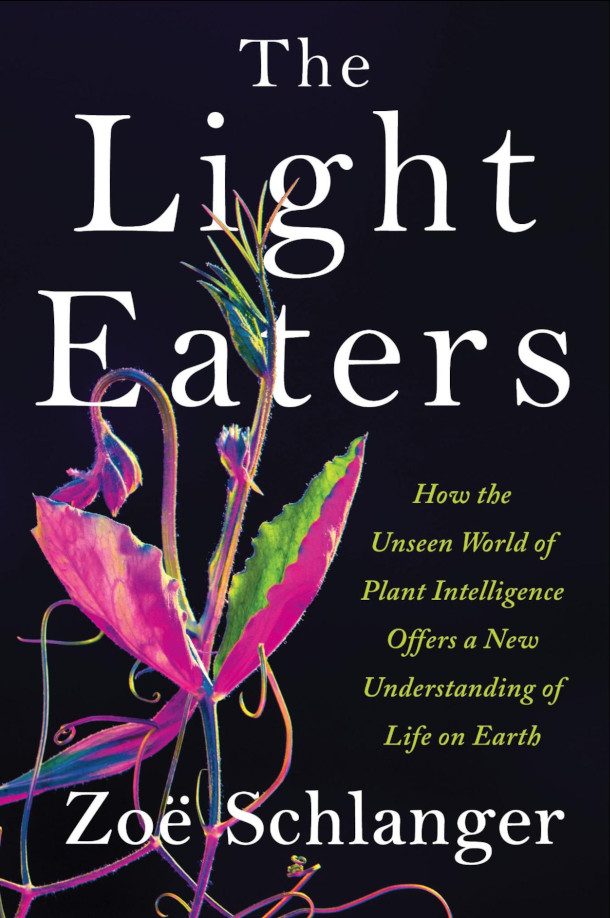
Zoë Schlanger’s book The Light Eaters: How The Unseen World of Plant Intelligence Offers a New Understanding of Life on Earth delves into topics like plant sensation, communication, sociality, and intelligence. (Photo: Courtesy of HarperCollins)
A scientist who rappels down cliffs to hand-pollinate endangered plants. A vine that mimics the leaves of nearby species. Rice that crowds out strangers but leaves room for the roots of relatives. All of these are subjects of the book The Light Eaters by Zoë Schlanger, who tackles big questions of plant intelligence, consciousness, and communication. She joins Host Steve Curwood to talk about what we might discover when we look closely at the green life around us.
Transcript
DOERING: It’s Living on Earth, I’m Jenni Doering.
CURWOOD: And I’m Steve Curwood.
A scientist who rappels down cliffs to hand-pollinate endangered plants. A vine that mimics the leaves of nearby species. Rice that crowds out strangers but leaves room for the roots of relatives. All of these are subjects of the book The Light Eaters, by Zoë Schlanger, who tackles big questions of plant intelligence, consciousness, and communication. Welcome to Living on Earth, Zoe!
SCHLANGER: It's so great to be here.
CURWOOD: So, early in your book you write, "I was regaining material intimacy with the natural world by looking at plants. It wasn't a way to ignore environmental catastrophe, it was a way to reattach myself to the stakes." So how can studying plants change our perspective of the climate emergency we're in right now?
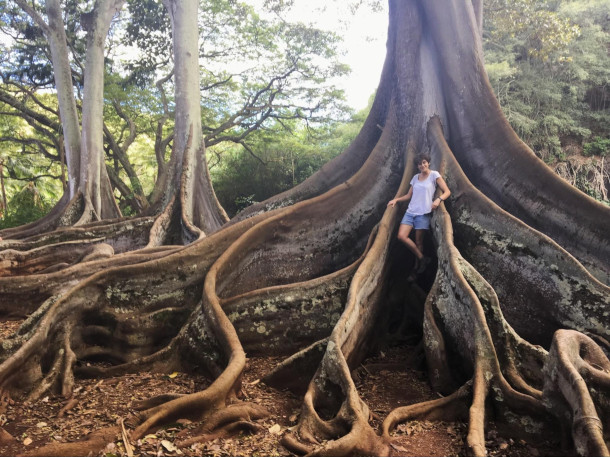
Author Zoë Schlanger stands by a Moreton Bay fig tree at National Tropical Botanical Garden in Kauai, Hawaii. It can be humbling to remember that every molecule of glucose we’ve ever consumed was first created by a plant through photosynthesis. (Photo: Gloria Dickie)
SCHLANGER: So I'm a climate reporter. And I came to this project out of feeling quite numb and fatigued, as many of your listeners probably also feel, about all of the bad news related to climate change. And I think the biggest takeaway for me of studying plants for the last several years was the incredible creativity that exists in biology and evolutionary trajectories, and the ways that plants make a living exactly where they're rooted in place. They find ways to thrive against all circumstances, despite not having brains, in incredibly cunning ways. And I think as it relates to my own kind of muddled feelings and numbness around climate change, it really reminded me of the worth of trying to protect as many species as possible, because every single one of these is a remarkable feat of ingenuity from a biological standpoint. And it really helped me expand my mind beyond the few plants that we actually use in our human economies to just actually have this appreciation for all plant life. And it's very humbling to remember that we're also entirely dependent on them. You know, every molecule of glucose we've ever consumed was first made by a plant; it made it through photosynthesis, through sunlight and water and air. So it really rearranges one's sense of where you are in the so-called hierarchy of life and reminds you that life finds a way.
CURWOOD: So as you point out, plants don't have brains. And yet, you've written a book about plant intelligence. Square that circle for me, please.
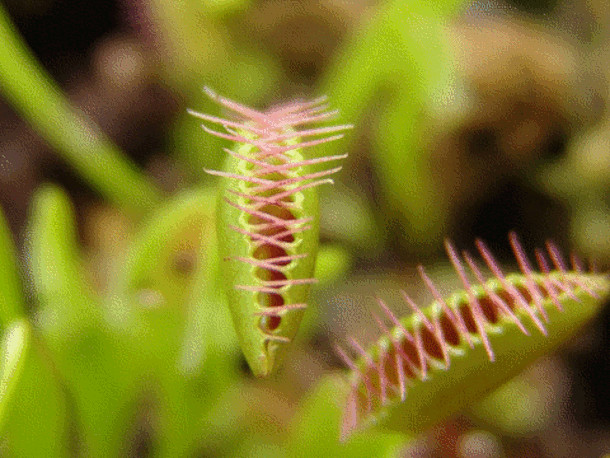
When an insect (or a toothpick) touches the hairs on a Venus Fly Trap’s mouth-like leaf, it provokes an electrical signal that triggers the leaf to close. (Image: Mnolf, Wikimedia Commons, CC BY-SA 3.0)
SCHLANGER: Sure. I mean, this is the million-dollar question. Scientists are understanding now that plants are able to respond in remarkably dynamic ways to their environment and make good choices for their future. They're able to record information about the past and use it in their decision making. They can sense their kin, they can communicate, all of these incredible things. And they do it all without a brain. And no one has answered the question yet of how all of this information is integrated in a plant body without centralized processing. But there's actually really good evolutionary theory for why a plant wouldn't produce a brain but might be able to do remarkable things regardless. We evolved a brain in part because we had to move across long distances to gather food, to flee from threats, we needed something really compact and portable. Plants, on the other hand, had none of those particular constraints. They had other ones. They needed to be able to stay in one place, but also sense their environment and also easily lose a limb or two when it called for it, without being damaged in some major way. So you end up with this kind of decentralized, modular creature that somehow is able to still integrate information across its whole body, to make good choices about where to grow, and how to find food. So that is really this huge open question of how they integrate this information without a brain.
CURWOOD: At one point, you make a comparison to the brains that animals have and the, the number of neurons and everything in their brain versus what plants have for ways to sense what's going on around them.
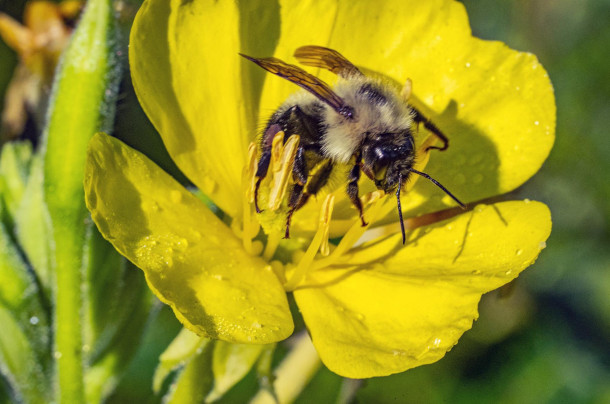
The evening primrose will increase the sweetness of its nectar when it vibrates at the same frequency as a bee buzzing. (Photo: Steve Guttman NYC, Flickr, CC BY-NC-ND 2.0)
SCHLANGER: Yeah. Well, it's important to mention that plants do not have neurons, there's no synapses, there's not nervous conduction in the literal sense that we think of with our own brain and our own bodies. But there is electricity moving through a plant body. And there's been plenty of work finding that certain activities in plants are mediated by electricity in the sense that a Venus flytrap, when it closes, it's because these little trigger hairs on the inside of its maw, its mouthlike leaf, have been flicked by a wriggling fly or whatever it's just caught. And each one of those little flicks is associated with a flash of electricity, an action potential. And that's what triggers the trap to close. So there are somehow ways for this plant to experience the phenomena of touch and respond to it in kind. There's chemicals being exuded that the plant can emanate from one branch, and then another branch of it can absorb those chemicals and register them as information. So there's no brain, there's no neurons. And yet there is this whole-body connectivity that we see in plants, which is quite remarkable.
CURWOOD: Let's go back to the 1970s, when an influential book called The Secret Life of Plants was published. What was the impact, do you think, of that book? And how did it shape your approach to writing this book?
SCHLANGER: The Secret Life of Plants absolutely haunted every single day of reporting on this book, because you can't talk to a botanist now who doesn't acknowledge the way that it tanked the field for a full generation. This book was incredibly influential. Never before had a work of botany broken onto the popular scene so powerfully. I mean, there was a feature film, Stevie Wonder wrote the soundtrack, it's a very good soundtrack. And this is where people began talking to their plants, or had the idea that plants enjoyed classical music more than rock and roll, all these pretty pseudoscientific ideas that were inside this book.
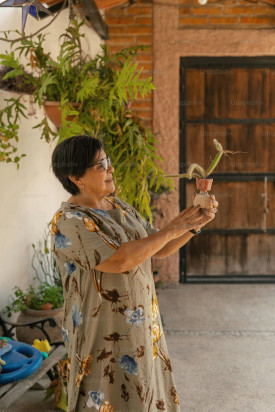
The book The Secret Life of Plants, published in 1973, popularized the idea that it is beneficial to talk to your plants, and that they prefer classical music to rock & roll. There is little evidence to support these ideas, but plants do respond to sounds, such as that of a bee buzzing or a caterpillar chewing. (Photo: Jordan González, Unsplash, Unsplash+ license)
CURWOOD: So wait - is that pseudoscientific, that there might be a response to us talking to our plants?
SCHLANGER: As far as I know, there's no reason a plant would respond to us talking. Although there's amazing work being done now in the world of phytoacoustics in terms of plants responding to sound. They certainly do, but more likely it's sound that's ecologically relevant to the evolutionary history of that plant. We've only been with plants for a mere few thousand years; plants have been evolving for millions and millions of years. So it doesn't make a lot of sense for them to be responsive to our talking, although probably if you talk to your plants, it means you're a much better plant parent than you would be otherwise, and they probably love that.
CURWOOD: What about singing to them, or banging a drum, which would go back thousands, millions of years?
SCHLANGER: That would be an interesting thing to test out. I mean, what we do know is plants can respond to the sound of a caterpillar chewing, or a bee buzzing, and will make adjustments. Evening primrose will increase the sweetness of its nectar by three times very quickly, when it starts to vibrate at the same frequency as a bee flying by or buzzing. Plants are very receptive to vibration. It's a physical stimulus. So to them sound is pure vibration. So who knows? I mean, there's probably a lot of sounds that plants are receptive to.
CURWOOD: And plants can feel pain, or at least they send out signals indicating that they've been pinched. Please describe the experiment that demonstrated that to you.
SCHLANGER: Yeah. Well, to be super clear, there's nothing to suggest they can experience pain in the way that we experience pain, as this like displeasing sensation. But we do know that when a plant is injured, when it's, let's say, clipped, or bitten by a predator, or bent, that will produce a flurry of defensive chemicals to make itself either less palatable, make its leaves very bitter, or send out warnings to other plants in the area that there's an attack underway. Or at least those plants are able to pick up on those chemicals from that injured plant and recognize that they have to boost their own immune systems. So certainly plants produce strong reactions to being hurt. And I think about this now every time I touch a houseplant. I was able to go to a, a lab in Wisconsin that is working with plant wounding experiments, and they've imbued these plants with these fluorescent green proteins from jellyfish. And those proteins are attached to calcium, which is typically seen as a precursor or like a signal that there's some electricity moving through a cell. And so they handed me tweezers, we're in this dark microscope lab, and I pinch the plant with the tweezers, and suddenly there's this green eminence glowing from the place that I've pinched this plant, then it starts traveling down its vein system. And within about two minutes, the entirety of this little plant had received the signal of my pinch.
CURWOOD: Well, and in the course of this experiment, they had to encourage you to pinch harder.
SCHLANGER: It's true. Yes, I mean, think about it, you've just been told that plants can feel you touching them, and then you're expected to enthusiastically wound this plant. It felt like the vegetal version of the Milgram shock experiment. But then I remembered, of course, I eat salad, it's okay. Pinch the plant. And, and I did and it was pretty spectacular to see.
CURWOOD: Speaking of eating salad, though, what does your work tell us about veganism? I mean, what moral superiority is there in just eating plants if plants are sentient beings as well?
SCHLANGER: I think it's a really interesting question, because we are animals that have to eat plants, there's no way around it. We need their sugars and proteins to keep ourselves alive. But it does start to bring into conversation this idea that, well, maybe every living thing is bent towards life and wants to keep living. And plants are no exception to that. I mean, it's interesting to try to have to hold in your mind that you, in order to survive, have to enact some violence on an organism that wants to keep living. And what does that mean? I mean, maybe it can introduce a sense of profound gratitude, or respect, or reciprocity with other creatures, and maybe that can shape how we treat them.
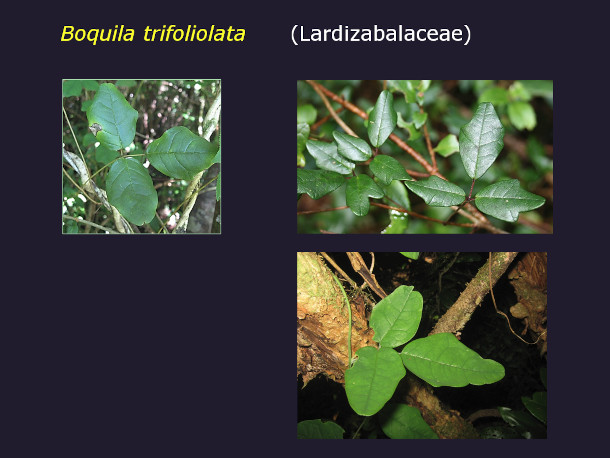
The vine boquila trifoliolata is known to mimic the leaf shape, texture, and color of nearby plants. These images show boquila leaves in their “original” state, not mimicking other plants. See below for images of boquila engaging in mimicry. (Photo: Courtesy of Ernesto Gianoli)
CURWOOD: So to what extent does your work suggest that plants have consciousness?
SCHLANGER: Well, consciousness is this incredibly alluringly mushy concept. We don't know the mechanical basis for consciousness even in ourselves. We can't verify the consciousness of anyone but ourselves. It's something we feel, but it's extremely hard to pin down. And consciousness in some ways could be seen as simple as the capacity to take control of one's life and guide one's actions according to your best abilities, a sense of experiencing the world. And these are not outside of the realm of things that you can consider plants doing if you look at them a certain way, if you look at all of the science coming out and holding in mind that there are realms of thought that believe that consciousness began with the very first cell even. So we're deep in the area of theory here, and there's no easy answers, but it at least is an intriguing thought experiment that I think could really rustle us out of this kind of sense of human superiority in this realm.
CURWOOD: So throughout your research process for this book, you traveled around the world and met a whole cast of, of characters. What was that like? And talk to me about one of your favorite characters from this.
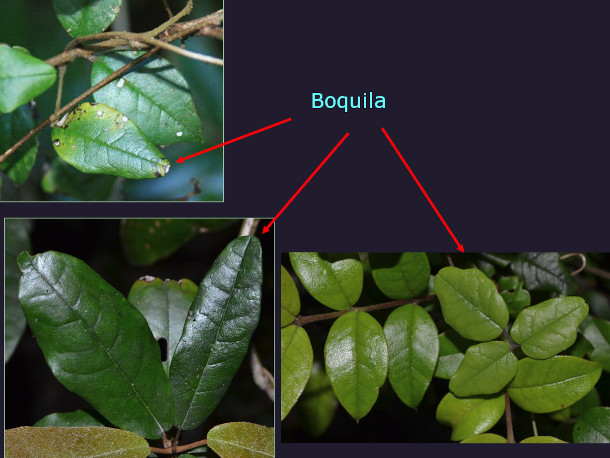
The leaves of boquila trifoliolata mimicking those of other plants. Scientists have differing theories about what enables this mimicry. Some believe that boquila is processing visual information about its neighbors. Botanist Ernesto Gianoli thinks boquila may be interacting with the microbiomes of other plants. (Photo: Courtesy of Ernesto Gianoli)
SCHLANGER: Botanists are some of the most wonderful scientists to talk to, in part because they have so much feeling for organisms that many of us maybe ignore, perhaps in favor of animals. I mean, I think about the fact that most of us can tell the difference between like a codfish and a toucan or something, but we can't tell the difference between wheat and rye, which are incredibly different species themselves. So these are people who have profound connections to these much-ignored organisms. And their research is also mind-blowing. One of my favorite trips was to the southern rainforests of Chile, these temperate rainforests, kind of chilly, wet places. And there is a vine that grows in this rainforest called boquila trifoliolata. And this vine has, of course, always been there, at least for human memory. But it was just recently discovered to be quite literally a chameleon vine. It can spontaneously change the shape of its leaves, the color of its leaves, the vein pattern, the texture, to match the shape, to mimic the shape of anything it's growing beside. This plant can mimic up to four different species at the same time, with different parts of its vine structure. And no one knows how this is possible. So I spent several days with the team of Ernesto Gianoli, a researcher who's studying this plant, and the vine has provoked this controversy over whether or not plants could possibly see. There are a camp of botanists who say, well, it's mimicking, spontaneously mimicking other plants--that must be a form of visual acuity, that they're taking visual information and processing it and producing this perfect mimic. But of course, plants don't have brains. So where would they be transposing that visual information into an image in the way we think of it? But plants do have a ton of photoreceptors on their leaves, more than we have in our eyes, more different types of photoreceptors. So there's some weight behind that argument. And then, the botanist himself who I was spending time with thought it was something far more sci-fi, that this plant was actually just receptive to the microbiomes of other plants, that the shape of plants is not determined by the plant itself, but rather by sort of third-party organisms. I mean, we talk a lot about the human microbiome and all these other creatures that live on and inside of us that dictate certain things about our own behaviors, let's say our mood, or our, our gut health. And he thought, well, maybe it's some kind of microbial takeover in that way. And this vine was just more receptive to that of other species.
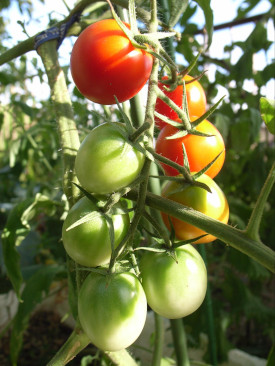
Tomato plants can sense the particular species of caterpillar that is chewing on them, then emit chemical signals to attract a wasp that parasitizes that caterpillar. (Photo: Toshiyuki IMAI, Flickr, CC BY-SA 2.0)
CURWOOD: So if you wouldn't mind, if you could open your book to page 183. So you're talking to the scientist Gianoli, and if you could pick up with that line, "We sit down on a log."
SCHLANGER: "We sit down on a log covered in pink and orange slime molds. Gianoli talks about the fact that termites were recently discovered to have microbes in their guts that make it possible for them to digest the chemicals in wood. In other words, the most signature behavior of termites--wood eating--is made possible by entirely different organisms living within them. The termite's gut microbes, in turn, are able to function thanks to yet smaller microbes that live within them. The presence of these animals-inside-animals predates the evolution of the termite itself--some termite ancestor likely acquired them by eating dead plant material where microbes were living. From there, both evolved together into the versions of each that exists today. One species of Australian termite is known to have a protist in its gut that in turn carries around four types of bacteria of its own. So many cascading individuals make a termite possible. 'They're independent, they're from different families, it's crazy,' Gianoli said. Over and over, the thrust of these new discoveries points in the same direction: a termite is never just a termite. The same is clearly true for every organism."
CURWOOD: Zoë, this theme of organisms being not just individuals, but a part of a larger ecosystem, this comes up a lot in your book. Tell me more about that.
SCHLANGER: Well, very quickly into researching this book, which is very firmly about plants, I realized it's really hard to tell where a plant starts and where a plant ends, because a plant is so hooked into and influenced by so many other organisms. I mean, fungi, for example, are entwined in the roots of virtually every single plant grown in the wild. And they're so a part of plants that some have posited that roots first evolved simply to house fungi. And they're interacting with microbes and viruses and molds, any number of other organisms all the time. It really is shaking the core of the idea of a biological individual. I mean, our selves are not biological individuals--something like half of our cells belong to other organisms, have foreign DNA. And they may well be influencing things we think of as wholly the domain of our own bodies, things like our health, things like our mental state. We are not just one creature, we are highly dependent on and enmeshed with so many others.
CURWOOD: So what were some of the most surprising things, beyond the things we've already talked about, that you learned when you were researching this book?
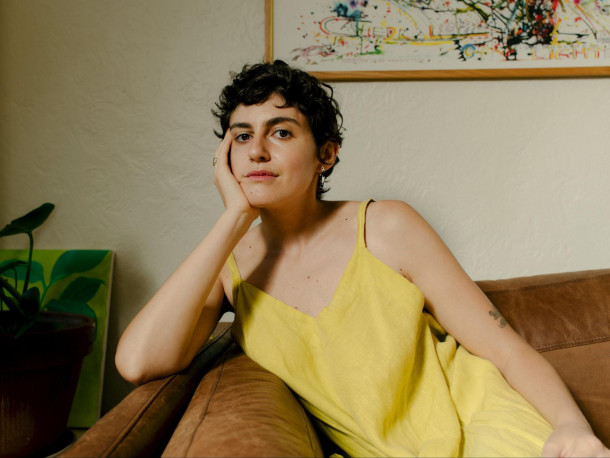
Zoë Schlanger is a reporter at The Atlantic and the recipient of a 2017 reporting award from the National Association of Science Writers. (Photo: Heather Sten)
SCHLANGER: I loved learning about the ways that plants can manipulate other creatures, even animals. They are able to kind of take the reins of a lot of other organisms. Plants have this entirely separate sense that we have none of, essentially, that is chemical synthesis. They are able to produce chemicals in their bodies that they then let out through pores on their leaves that infiltrate the bodies of others and make them do things. And so one example of this is the humble tomato plant. The tomato plant is able to sample the saliva of a caterpillar chewing on it, and from there, make a chemical that will summon the exact predatory wasp that will want to come inject its eggs into this caterpillar, and the eggs will then hatch, and the larvae will eat the caterpillar from inside out and glue its little white cocoons to the outside of this husk of a caterpillar. And this is how this tomato plant attempts to defend itself from the hungry mouths of a million caterpillars. It's really remarkable when you think about a plant manipulating an animal, it really turns a lot of ideas upside-down.
CURWOOD: So what does studying plants tell us? What's the message?
SCHLANGER: Well, I can only say what learning all of this has done for me. And at a very simple level, these findings, these scientific developments around plant behavior, produce this immense feeling of awe, at least in me. And I know Rachel Carson wrote about this a bit towards the end of her life, and many people have studied this, that the experience of awe leads directly towards respect and sort of away from negligent behavior or away from indiscriminate destruction. And injecting ourselves with a big dose of awe could only do good things both for addressing climate change and just for being animals in this world.
CURWOOD: Zoë Schlanger's book is called The Light Eaters. Zoë, thanks so much for taking the time with us today.
SCHLANGER: It's been wonderful talking with you. Thank you.
Links
Find a copy of The Light Eaters (Affiliate link helps donate to LOE and local indie bookstores)
Learn more about author Zoë Schlanger
Zoë Schlanger’s profile at The Atlantic
New York Times | “Are Plants Intelligent? If So, What Does That Mean for Your Salad?”
Living on Earth wants to hear from you!
Living on Earth
62 Calef Highway, Suite 212
Lee, NH 03861
Telephone: 617-287-4121
E-mail: comments@loe.org
Newsletter [Click here]
Donate to Living on Earth!
Living on Earth is an independent media program and relies entirely on contributions from listeners and institutions supporting public service. Please donate now to preserve an independent environmental voice.
NewsletterLiving on Earth offers a weekly delivery of the show's rundown to your mailbox. Sign up for our newsletter today!
 Sailors For The Sea: Be the change you want to sea.
Sailors For The Sea: Be the change you want to sea.
 The Grantham Foundation for the Protection of the Environment: Committed to protecting and improving the health of the global environment.
The Grantham Foundation for the Protection of the Environment: Committed to protecting and improving the health of the global environment.
 Contribute to Living on Earth and receive, as our gift to you, an archival print of one of Mark Seth Lender's extraordinary wildlife photographs. Follow the link to see Mark's current collection of photographs.
Contribute to Living on Earth and receive, as our gift to you, an archival print of one of Mark Seth Lender's extraordinary wildlife photographs. Follow the link to see Mark's current collection of photographs.
 Buy a signed copy of Mark Seth Lender's book Smeagull the Seagull & support Living on Earth
Buy a signed copy of Mark Seth Lender's book Smeagull the Seagull & support Living on Earth

